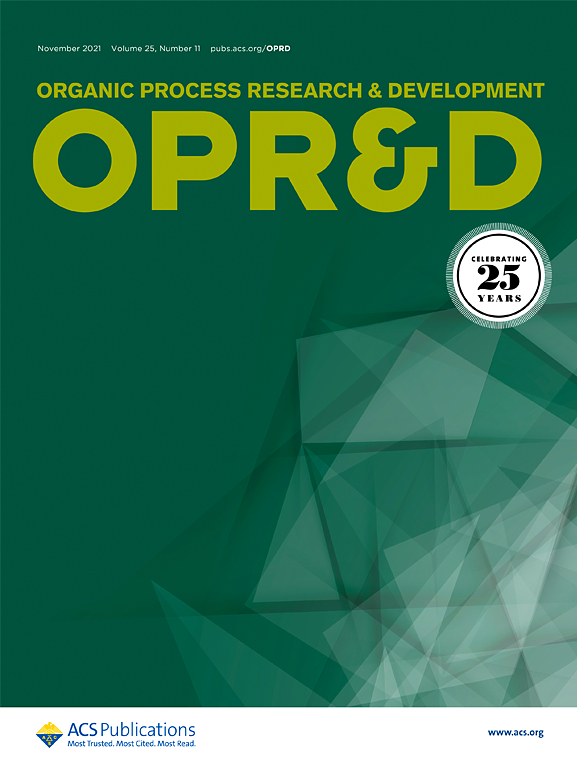测定粒径和表面积对药粉最小点火能的影响
IF 3.1
3区 化学
Q2 CHEMISTRY, APPLIED
引用次数: 0
摘要
粉尘爆炸在许多工业中构成重大危险。为确定需要采取缓解战略的材料,需要了解每种材料的相对风险。这些信息将包括诸如最小点火能量(MIE)等特征,但材料的可用性对于制药工业在早期发展阶段来说是一个重大挑战。这些挑战与风险表征相对较高的材料要求形成对比。为此,人们对应用模型来预测MIE非常感兴趣。这项研究的目的有两个方面。第一阶段是评估已发表的MIE预测模型对一系列药物粉末的预测强度。研究的第二阶段是研究一系列“恒定化学”和不同大小的样品中粒径的作用。结果表明,该模型为一半的测试材料提供了“安全”的结果,而模型的准确性令人不满意。结果表明,风险往往被高估;因此,安全缓解所需的工作不会为该过程增加价值,或被低估,从而增加了安全缓解不足的风险。当材料的化学性质保持不变时,粒径和表面积与测量的MIE之间的关系存在显著差异。总的来说,这项工作表明,化学和颗粒性质对MIE的相对影响在材料之间表现出显著差异,从而影响了评估模型准确预测MIE的能力。本文章由计算机程序翻译,如有差异,请以英文原文为准。

Determining the Influence of Particle Size and Surface Area on the Measured Minimum Ignition Energy of Pharmaceutical Powders
Dust explosions constitute a significant risk in many industries. To identify materials for which mitigation strategies are required, information about the relative risk for each material is required. Such information will include characteristics such as the minimum ignition energy (MIE), but material availability represents a significant challenge for the pharmaceutical industry at early stages of development. These challenges contrast with the relatively high material requirements for risk characterization. To this end, there is significant interest in the application of models to predict MIE. The aims of this study were 2-fold. The first stage was to assess the predictive strength of a published MIE prediction model for a range of pharmaceutical powders. The second stage of the study was to investigate the role of particle size for a series of samples of ‘constant chemistry’ and varying size. The results demonstrate that the model provided ‘safe’ results for half the materials tested while the accuracy of the model was unsatisfactory. The results showed that the risk was often overestimated; thereby, the work required for safety mitigation would not add value to the process, or underestimated, raising the risk of inadequate safety mitigation. When the chemistry of the materials was maintained constant, significant differences in the relationship of particle size and surface area with the measured MIE were demonstrated. Overall, the work suggests that the relative influence of chemistry and particle properties on MIE shows notable differences between materials, thereby affecting the ability of the assessed model to accurately predict MIE.
求助全文
通过发布文献求助,成功后即可免费获取论文全文。
去求助
来源期刊
CiteScore
6.90
自引率
14.70%
发文量
251
审稿时长
2 months
期刊介绍:
The journal Organic Process Research & Development serves as a communication tool between industrial chemists and chemists working in universities and research institutes. As such, it reports original work from the broad field of industrial process chemistry but also presents academic results that are relevant, or potentially relevant, to industrial applications. Process chemistry is the science that enables the safe, environmentally benign and ultimately economical manufacturing of organic compounds that are required in larger amounts to help address the needs of society. Consequently, the Journal encompasses every aspect of organic chemistry, including all aspects of catalysis, synthetic methodology development and synthetic strategy exploration, but also includes aspects from analytical and solid-state chemistry and chemical engineering, such as work-up tools,process safety, or flow-chemistry. The goal of development and optimization of chemical reactions and processes is their transfer to a larger scale; original work describing such studies and the actual implementation on scale is highly relevant to the journal. However, studies on new developments from either industry, research institutes or academia that have not yet been demonstrated on scale, but where an industrial utility can be expected and where the study has addressed important prerequisites for a scale-up and has given confidence into the reliability and practicality of the chemistry, also serve the mission of OPR&D as a communication tool between the different contributors to the field.

 求助内容:
求助内容: 应助结果提醒方式:
应助结果提醒方式:


